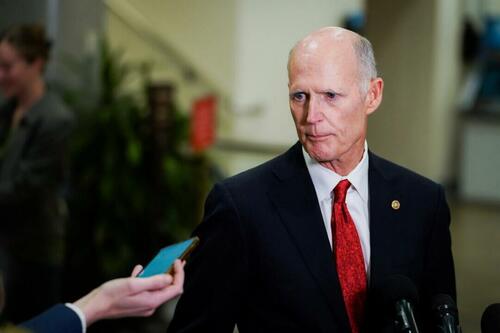Removing The “Great” From Britain
Authored by Paulo Ferreira via The Mises Institute,
Last month, Britain made a dangerous swing to the left. Private education has been attacked, more public housing, the promotion of environmental Marxism, and much more. But that isn’t to say there wasn’t an unspoken gospel among the main parties concerning the deliberate impoverishment of the British Isles. Merely aesthetic differences separate them.
A distinguished associate of mine told me about his grievances, the attacks against people earning lower wages and the political weaponization used by both major parties to score points from the electorate. He also mentioned the infuriating behavior of leftist Samaritans preaching love, but when people vote contrary to their intentions, spew irascible diatribes.
Disappointing as it is, I am not terribly surprised. It would be a mistake to label the conservatives as oriented by free-market liberalism. Some permitted the organization of market forces; others such as Robert Peel, Margaret Thatcher and John Major were proponents of individual liberty.
The notion of one-nation conservatism, also known as Tory democracy, was conceived by Benjamin Disraeli, espousing the belief of a united nation protecting working classes against alleged abuses of capitalism. As prime minister in the 1870s, his government passed the Employers and Workmen Act and the Conspiracy and Protection of Property Act, the latter decriminalizing trade unionism. Social reforms were introduced to smooth relations between Capital and Labor.
Despite these inroads into statism, Britain retained a mostly free-market economy, but the seeds were planted for a seditious social revolution to sprout. As one has read, there are overlaps with socialism. Therefore, it comes as no shock that the first socialist party (Social Democratic Foundation) in Great Britain was founded by Henry Hyndman, a former conservative. His political career foreclosed with his death as leader of the National Socialist Party in 1921.
The calamities of World War I quickly brought Labor into the political spotlight, inspired by the guild socialism of Sidney and Beatrice Webb. Britain abandoned the gold standard in 1931, and in 1945, Labor imposed price control, expropriated businesses and instituted the welfare state, all acquiesced by Winston Churchill, an irreligious “liberal” who maintained the policies of his predecessor — except for the privatization of steel — and praising the powerful trade unions in the name of Tory Democracy at the Conservative Party Conference in 1953; the same inebriate collaborator of Soviet expansionism.
The following decades would be even worse. The Winter of Discontent and severe inflation followed; unprofitable industries were subsidized, leading to wasteful resources. Entire sectors and industries were crippled by trade disruption. Trash wasn’t taken out and the deceased weren’t buried. Food wasn’t being transported, and hospitals and schools shut down. No doubt the Trades Union Congress — a privileged caste disregarding economic welfare — were following orders from the Kremlin.
The premierships of Thatcher and Major represented a paradigm shift concerning the (reduced) role of the state. Yet despite the successes achieved in 18 years away, it wasn’t enough to keep voters away from New Labor, swayed by the charisma of Tony Blair.
It’s true that his government never pursued Keynesian measures, and the memory of the Soviet Union, omnipotent government control, gulags and poverty was still fresh in the minds of many people. Socialism was deeply unpopular. But Blair set out socialization through the destruction of British cultural values and traditions beset by mass immigration and political correctness now threatening to shake the foundations of people’s livelihoods.
No wonder the left collaborates with Islamists — they prohibit the use of usury, a central pillar of consumer time preferences, signaling a preference of present or future consumption. Low time preferences translate into earning and accumulating capital, which is denounced by adherents of Islam, who merely consume their resources, hence their lower living standards and baseless theology devaluing civilizational advances and standards.
Love requires care and cultivates patience; hatred is opaque, facilitating destruction.
In 2024, hedonistic behavior is encouraged and boundaries are disrespected. It is why those of a lower cultural and religious order refuse to integrate themselves in countries settling them. Bolshevism was born at the Second Congress of the Russian Social Democratic Labor Party in London. And it was under a Labor administration that diplomatic relations were established with the Soviet Union.
The modern man, stripped of his past, can be molded to be anything: at worst a bee worker for Downing Street.
However, it is worth remembering the nearly forgotten 1997 Conservative Manifesto, displaying an outlook consistent with Paleolibertarianism. Let’s transcribe some of it:
“Our aim is nothing less than tariff free trade across the globe by the year 2020.”
“The family is the most important institution in our lives. It offers stability and security in a fast-changing world. But the family is undermined if government takes decisions which families ought to take for themselves. Self-reliance underpins freedom and choice.”
“People are not just saving for themselves but for their children and grandchildren. These savings should not be penalized by the tax system.”
In a short monograph accompanying the manifesto titled “Why I vote Conservative,” we can find the following quote on page 13:
“The best way to improve the performance of British industries is to expose it to as much competition as possible.”
The conservatives would do well to learn from the past, pages of liberty lost to time. But the massive 1997 defeat conditioned subsequent conservative leaderships advocating policies contrary to freedom: LGBT rights and legalization of same-sex marriage, covid lockdowns, quantitative easing and the highest tax burden on record since the Second World War. Inflation is at an all-time high, and as many are aware, perpetual buzzing of the printing machine erodes savings and destroys all productive jobs in the economy, transferring purchasing power from the worker to the state (a stealth tax).
Some within Europe dream of Britain’s return to the European Union and USSR in tandem with the 2030 agenda. Even continental liberals — who misunderstand liberty — championed Labor’s massive victory. And it’s not a one-sided relationship.
Starmer recently announced his intentions of increasing trading ties with the E.U. through a damaging veterinary deal forcing the U.K. into adopting regulations on food and agriculture in accordance with the European Court of Justice, alongside better access for E.U. fishermen within British waters.
It’s ironic that the reinforcement of leftism in Britain came on the Fourth of July, as Americans extricated themselves from the tyranny of King George. Today it’s a new tyranny overwhelming the British population.
Nationalism is truly alive. The new Labor government plans a national renewal by creating Great British Energy, Great British Railway, and the National Healthcare Service — all acrimonious attacks against the British taxpayer and his freedom of choice.
Nationalized industries, not subject to competition, have little incentive for improvement while providing inferior services. The nation does not benefit from these exuberant indulgences of Whitehall. British Airways proudly flies the Union Jack without recourse to public ownership.
A monarchical system of government provides protection of property rights unknown in republican states, where the hands of power are constantly shifting. A monarch will protect his subjects for generations (a low time preference by maintaining a reputable value of the kingdom). This republican stride within the Labor Party is more prevalent given their ambition of abolishing the monarchy.
All this nationalism, after all, goes contrary to King Charles’ genealogical roots: German, Scottish, Greek and Danish (House of Glücksburg). Keir Starmer is just English and plainly boring.
British National Socialism is unfortunately here to stay. Opposition is being extirpated, politically and through social media and traditional media outlets. But the people of these great isles are strong and pragmatic.
The history of Britain is replete with manumissions of her subjects throughout the centuries. The Magna Carta and Glorious Revolution curtailing political absolutism set the precedence for the separation of power that has since been emulated — unsuccessfully — across the globe. A beacon of liberty housing a great line of liberals such as William Hutt, Friedrich Hayek, Edwin Cannan, and Arthur Seldon, among others. The cornerstone to stability is tradition and prosperity through peaceful evolutions.
As Ludwig von Mises wrote in 1919, “Living in the same places and having the same attachment to a state do play their role in the development of nationality, but they do not pertain to its essence. It is no different with having the same ancestry.”
What shapes the nation is our individuality. Without individualism, there is no identity.
Tyler Durden
Sun, 08/18/2024 – 07:00
via ZeroHedge News https://ift.tt/TJ0rOEK Tyler Durden

















